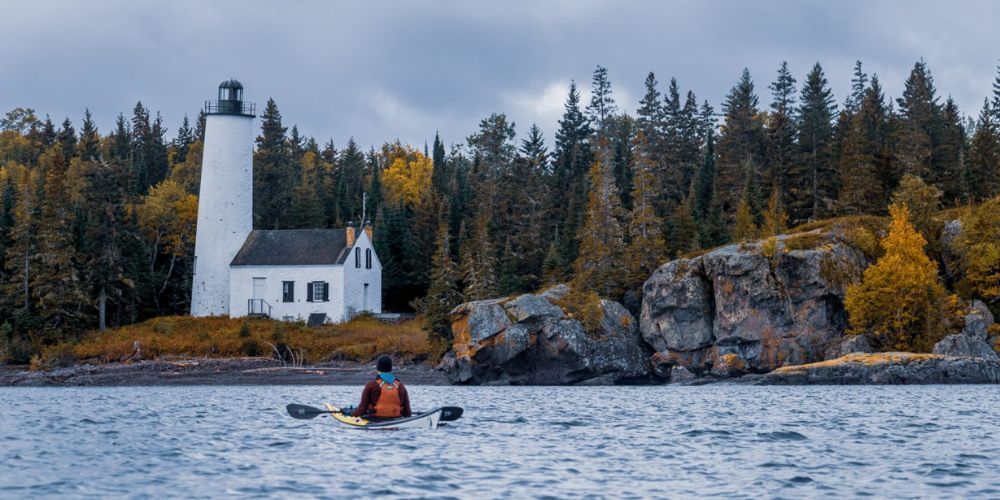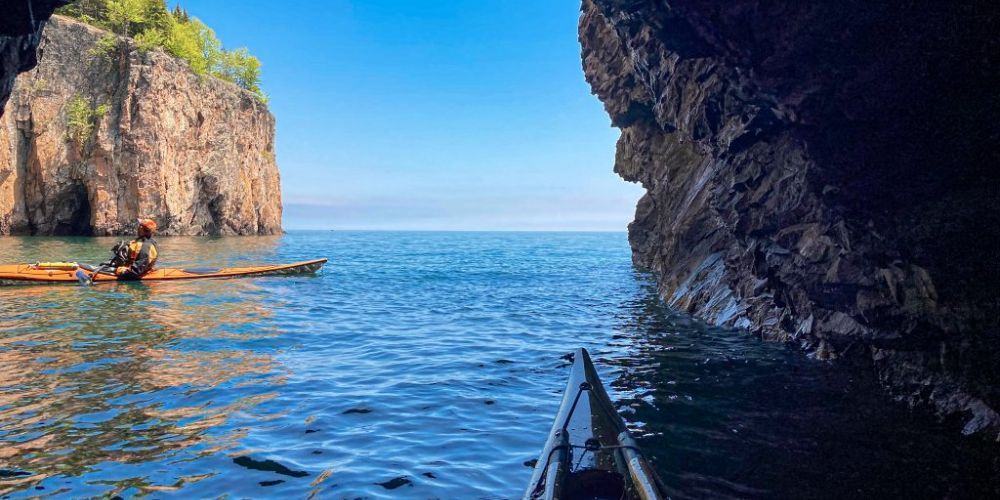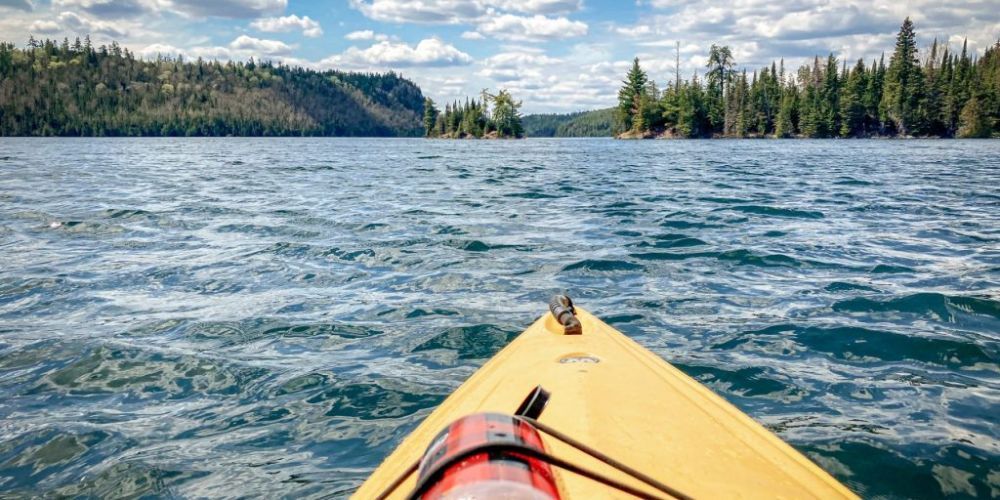Kayaking in Minnesota: Discover the Best Lakes and Rivers for Adventure
Minnesota's waterways offer kayakers unparalleled beauty and variety, making it an outstanding destination for paddling adventures. From the crystal-clear expanse of Lake Superior with its rugged coastline and captivating Apostle Islands to the serene wilderness of the Boundary Waters Canoe Area with over 1,000 pristine lakes, there’s something here for every paddler seeking both challenge and tranquility.
Each location presents unique characteristics—like spotting diverse wildlife along stretches of the Mississippi River or navigating through Minneapolis’ interconnected Chain of Lakes, perfect for urban escapades. Alongside these captivating experiences are practical yet crucial details such as permits and optimal entry points often missed in other guides. Together, these elements ensure that this guide not only highlights destinations but equips you with all you need for an unforgettable kayaking journey in Minnesota.
The best kayaking spots in Minnesota include the Boundary Waters Canoe Area Wilderness, the Mississippi River, and Lake Superior's North Shore. Each offers unique experiences for kayakers of all skill levels.

Best Places to Kayak in Minnesota
If you're an outdoor enthusiast looking for incredible kayaking spots, Minnesota is packed with them. From picturesque lakes to winding rivers, there's something for everyone. Let's take a closer look at some of the best places to kayak in this beautiful state.
Lake Superior
Ah, Lake Superior - the largest freshwater lake in the world by surface area. This mammoth body of water offers stunningly clear blue waters and a rugged coastline that creates an epic backdrop for any paddling adventure. If you're up for exploring, the Apostle Islands are a must-see. These 22 islands boast sea caves and pristine beaches, providing an unparalleled experience for kayakers. Meanwhile, the iconic Split Rock Lighthouse is a sight to behold and adds a touch of history to your journey as you paddle under its watchful gaze.
Mississippi River
The Mississippi River flowing through Minnesota is another gem for kayakers. The stretch here offers diverse wildlife and postcard-worthy views that will make your time on the water truly memorable. The Grand Rapids area, with its tranquil setting and abundant wildlife, provides a serene kayaking experience. Additionally, the section near Winona offers striking bluffs and scenic landscapes that paint a breathtaking picture as you navigate its waters.
Chain of Lakes in Minneapolis
Urban kayaking more your style? Look no further than the Chain of Lakes in Minneapolis. This unique location features interconnected lakes like Lake Harriet, Lake Calhoun, and Lake of the Isles, offering an accessible and refreshing urban paddling experience. Whether you're a beginner or a seasoned pro, these lakes provide calm waters perfect for a relaxing day on the kayak. Not to mention, the surrounding parkland provides a beautiful setting for picnics or leisurely strolls after your paddle.
Each of these destinations has its own character and charm, promising unforgettable experiences for kayakers eager to explore the diverse natural beauty of Minnesota from the tranquility of their kayaks.
The Boundary Waters Canoe Area Wilderness
The Boundary Waters Canoe Area Wilderness (BWCA) is not just another kayaking spot – it's a vast, unspoiled sanctuary boasting over 1,000 lakes and streams. Imagine being surrounded by nature at its most untouched. There are no roads here, just pristine waterways and sprawling wilderness that offers an experience like no other.
When you venture into the BWCA, you're stepping into a world where the call of a loon across the water is your only alarm clock, the sky is your ceiling, and the tranquil waters are your playground. This isn't just about kayaking; it's about connecting with nature in its purest form.
Popular Entry Points and Historical Significance
As you make plans to explore this mesmerizing wilderness, it's essential to consider the popular entry points. The Ely area and the Gunflint Trail are two such gateways that beckon adventurers into the heart of the BWCA. Ely, in particular, is steeped in history, from its local outfitters who provide essential gear and guidance for a BWCA journey to its ties to the fur trading era. It's no surprise then that Ely acts as a reliable hub for visitors embarking on their BWCA expeditions.
Understanding the significance of these entry points adds an enriching layer to your adventure. Ely’s heritage as a gateway to explorers of old enhances the experience for present-day kayakers as they embark on their own voyages through history and nature.
Permits, Limits, and Respect for Nature
For those eager to immerse themselves in the wonders of BWCA, it's crucial to remember that this pristine haven requires careful preservation measures. Permits are required for entry into BWCA, and there's a cap on the number of permits issued at any given time. This cap ensures that the wilderness experience remains truly wild and authentic for all who seek it.
Adhering to regulations ensures a balance between human exploration and environmental conservation. By planning ahead, booking permits in advance and respecting these limitations, travelers contribute to maintaining the unspoiled quality of this natural treasure. Every paddle stroke into the BWCA then becomes not just a personal adventure but also a demonstration of respect for nature itself.
Remember to check the U.S. Forest Service website for detailed information on permits and regulations before embarking on your Boundary Waters adventure.
Overall, diving into the depths of BWCA offers not just an escape from bustling city life but an immersion into a truly untouched paradise. Its rustic appeal combined with historical significance makes it one of Minnesota's most sought-after destinations for kayaking enthusiasts seeking serenity amidst unspoiled majesty.
As we navigate our way through Minnesota's stunning waterways, our next destination introduces us to another gem—the breathtaking beauty of the St. Croix River.
The St. Croix River
The St. Croix River winds through a landscape that appears lifted from a postcard. As part of the National Scenic Riverway, it boasts lush forests, winds around dramatic sandstone cliffs, and plays host to an array of diverse wildlife. It's a place where adventure seamlessly blends with natural serenity.
One of the most sought-after stretches along this picturesque watercourse lies between Taylors Falls and Marine on St. Croix. The area is particularly favored for its striking cliffs and easily accessible put-in and take-out points, making it a great spot for both new kayakers and families seeking a relaxed yet stunning experience.
Safety First
However, with alluring beauty comes the need for caution and responsibility. Safety should always be a top priority when embarking on any adventure along the St. Croix River. It's wise to check the guidelines and get real-time updates on river conditions from reliable sources such as the National Park Service before you head out, as things change frequently.
It's essential to always respect the power of nature and arm yourself with knowledge about potential risks.
The St. Croix River offers not just a scenic kayak ride but also an opportunity to immerse oneself in the raw beauty of unspoiled nature. With its accessibility and breathtaking landscapes, it's no wonder that it holds a special place in the hearts of paddlers seeking both tranquility and adventure.
As kayaking enthusiasts continue their quest for thrilling water escapades, let's now turn our attention to an option that provides guidance and expertise to elevate your kayaking experience—enter the world of guided kayaking tours.
Safety First
Embarking on a kayaking journey with an experienced guide holds its charm, especially if you're new to the area. These guides are skilled in maneuvering the waters and often serve as living encyclopedias, sharing valuable insights about the local history and the rich wildlife that surrounds you. Imagine gliding through the water while listening to fascinating stories about the land and animals – it adds a whole new layer of depth and richness to your outdoor experience.
Perhaps you're paddling along Lake Superior near the Apostle Islands. Your guide may regale you with tales of shipwrecks, giving you a unique window into the area's maritime history. Or while navigating the St. Croix River, they might point out hidden caves and share folklore about the indigenous people who once called these lands home. Guides don't just show you around; they help you connect with a place in ways that aren't possible otherwise.
By opting for a specialized tour, you're presented with a variety of options, each offering its own unique blend of experiences. Whether it's a serene exploration of natural wonders or an adrenaline-filled jaunt through challenging waters, there's something for everyone.
One of the main benefits of joining a guided tour is the convenience it offers. Many tours include all necessary gear, sparing you from the hassle of lugging around kayaks and safety equipment. It's like having everything ready at your fingertips, letting you focus entirely on basking in the natural beauty around you.
Imagine being able to show up at the starting point with just your enthusiasm, knowing that everything from paddles to life jackets has already been taken care of by the expert guides. It not only saves time but also ensures that you have access to high-quality, well-maintained equipment without having to invest in your gear.
In essence, guided kayaking tours are more than just a paddle through picturesque waters – they open up a wealth of knowledge and experiences while ensuring your safety and comfort throughout the journey. With experts leading the way and providing all the necessary tools, these tours offer an effortless way to immerse yourself fully in the wonders of Minnesota's lakes and rivers.
As we've explored the enriching experiences offered by guided kayaking tours, let's now dive into the allure of embarking on overnight kayak trips amidst Minnesota's stunning waterways.

Guided Kayaking Tours
Imagine the tranquility of camping under the stars after a day of paddling through glistening waters. Overnight kayaking trips offer an immersive experience that deeply connects you with nature. Planning such adventures requires thoughtful preparation to ensure both safety and enjoyment.
When planning your route, consider the distance you aim to cover each day and identify camping sites along the way. The Boundary Waters Canoe Area (BWCA) in Minnesota offers remarkable routes for overnight trips, boasting stunning landscapes and serene camping spots. Researching and plotting your route in advance ensures that you're prepared for the journey and aware of potential challenges or exciting detours.
Campsites are essential for a safe and comfortable overnight trip. While many lakes and rivers in Minnesota provide designated campsites, it's important to check if reservations are required. Additionally, always adhere to the Leave No Trace principles to minimize your impact on the environment and preserve the natural beauty of these locations for future adventurers.
Now let's talk essentials for gear. Apart from your kayak and paddle, several items are crucial for an overnight kayaking trip. A reliable tent, a cozy sleeping bag, waterproof bags to protect your belongings, and a portable water filter are all essential gear. It's vital to pack extra provisions in case of emergencies or unexpected delays. Always be prepared for variations in weather conditions and potential changes to your itinerary.
Successful overnight kayaking trips hinge on thorough planning and preparation. By meticulously considering your route, securing suitable campsites, and packing the right gear, you'll lay the foundation for an unforgettable adventure on Minnesota's picturesque lakes and rivers.
With these key considerations at the forefront of your planning process, you're well on your way to having a safe, enjoyable, and fulfilling overnight kayaking experience amid Minnesota's natural wonders.

Overnight Kayaking Trips
Before heading out on your Minnesota kayaking expedition, it's essential to ensure you have all the necessary gear and supplies for a safe and enjoyable experience on the water. While it can be tempting to pack light, overlooking important items can turn a pleasant outing into a challenging ordeal. To make the most of your adventure, there are several key categories of items you'll want to consider when preparing for your journey: essential gear, clothing, and food and water.
Essential Gear
Here's where you want to focus on assembling the backbone of your supplies. A reliable personal flotation device (PFD) is non-negotiable—it's your lifeline during an unexpected capsize, making it vital for safety in case of an emergency. Your paddle should be suited to your skill level—there are different types for different disciplines, be it touring or whitewater paddling. Dry bags or waterproof containers will safeguard your valuables from water damage as you navigate the waters. A map or GPS device is crucial for navigation, especially if you're exploring new waterways. In case of emergency situations, a whistle can help signal for assistance, while a multi-tool covers a variety of potential needs on the go. Pair these with a basic first aid kit - better safe than sorry!
Clothing
When it comes to dressing for your adventure, flexible clothing choices are key for comfort and safety throughout unpredictable weather conditions. Always prioritize moisture-wicking materials that dry quickly to manage sweat and stay warm as temperatures change. Layering is important since you can add or remove clothing as needed.
In cooler months or during extended time spent in cold water, consider utilizing a wetsuit or drysuit to protect yourself from hypothermia. These specialized garments offer insulation and protection by keeping your body heat close.
Food and Water
Proper nutrition and hydration play a significant role in ensuring your comfort, energy levels, and overall well-being during your kayaking trip. Opt for high-energy snacks such as nuts, dried fruits, and energy bars that provide sustained fuel without taking up too much space. Pack easy-to-prepare meals that don't require refrigeration to minimize weight and keep things simple.
And when it comes to hydration, always carry more water than you think you'll need—paddling can be thirsty work! A portable water filter is also an excellent addition to ensure a continuous supply of clean drinking water along your route. Feeling free from concerns about food and water allows you to stay focused on the natural beauty around you as you paddle through Minnesota's stunning lakes and rivers.
Armed with the knowledge of what gear to bring, let's now prepare to make the most of our Minnesota kayaking experience with some valuable tips.
What to Bring for a Minnesota Kayaking Adventure
Minnesota, with its abundance of lakes and rivers, offers an idyllic setting for kayaking enthusiasts. Discovering these beautiful waters can be an exhilarating experience, but considering a few key considerations ensures both safety and enjoyment.
Check Weather Conditions
Before launching your kayak, always check the weather forecast. Strong winds and sudden storms can transform calm water into treacherous conditions, especially on larger bodies of water such as Lake Superior. Knowing what to expect helps you prepare accordingly and stay safe.
It's important to remember that the weather can change quickly, so it's crucial to continuously monitor the sky and listen for shifts in the wind while you're out on the water. If conditions start to deteriorate, it's time to head back to shore.
Know Your Skill Level
Paddling in Minnesota offers a variety of experiences for kayakers of different skill levels. If you're a beginner, start on calm, smaller bodies of water. It's integral to choose routes that align with your abilities to ensure a safe and enjoyable adventure.
As you gain more experience and confidence, you can gradually take on more challenging waters. In Minnesota, there's something for everyone—from serene lakes perfect for beginners to fast-flowing rivers that will excite seasoned paddlers.
Respect Nature
Kayaking provides a special opportunity to immerse oneself in nature, so it's important to do so responsibly. Following Leave No Trace principles is crucial. This means minimizing your impact on the environment by respecting wildlife, keeping noise levels down, and packing out all trash.
Respecting nature not only ensures that the beauty of these waters remains untouched but also fosters a harmonious relationship between humans and the natural world.
When exploring Minnesota's lakes and rivers by kayak, remember that safety and respect for nature are paramount. By adhering to these tips, you'll not only have a fantastic paddling experience but also contribute to the preservation of these spectacular outdoor environments for generations to come.
Author: William Flaiz
Check out these other activities in Minnesota
Check out activities in these nearby states: Wisconsin , Illinois , Iowa , South Dakota , North Dakota
All Rights Reserved | Sports and Nature Gear
